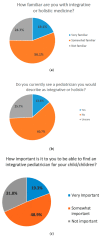Pediatric Integrative Medicine: Vision for the Future
- PMID: 30127308
- PMCID: PMC6111895
- DOI: 10.3390/children5080111
Pediatric Integrative Medicine: Vision for the Future
Erratum in
-
Correction: Esparham, A., et al., Pediatric Integrative Medicine: Vision for the Future. Children, 2018, 5, 111.Children (Basel). 2018 Sep 5;5(9):123. doi: 10.3390/children5090123. Children (Basel). 2018. PMID: 30189688 Free PMC article.
Abstract
Pediatric integrative medicine (PIM) is of significant interest to patients, with 12% of the general pediatric population and up to 80% of children with chronic conditions using PIM approaches. The field of PIM has evolved over the past 25 years, approaching child health with a number of guiding principles: preventive, context-centered, relationship-based, personalized, participatory, and ecologically sustainable. This manuscript reviews important time points for the field of PIM and reports on a series of meetings of PIM leaders, aimed at assessing the state of the field and planning for its future. Efforts in the first decade of the 2000s led to increased visibility in academic and professional pediatric organizations and through international listservs, designed to link those interested in and practicing PIM, all of which continue to flourish. The PIM leadership summits in recent years resulted in specific goals to advance PIM further in the following key areas: research, clinical practice, professional education, patient and family education, and advocacy and partnerships. Additionally, goals were developed for greater expansion of PIM professional education, broader support for pediatric PIM research, and an expanded role for PIM approaches in the provision of pediatric care.
Keywords: advocacy; clinical practice; complementary therapies; education; pediatric integrative medicine; vision.
Conflict of interest statement
The authors declare no conflict of interest. The funders had no role in the design of the summit, in the writing of the manuscript, or in the decision to publish the manuscript.
Figures




References
-
- Academic Consortium for Integrative Medicine and Health. [(accessed on 30 April 2018)]; Available online: https://www.imconsortium.org/about/about-us.cfm.
-
- National Center for Health Statistics . Health United States with Chartbook on Trends in the Health of Americans. National Center for Health Statistics; Hyattsville, MA, USA: 2006.
-
- GBD 2015 DALYs and HALE Collaborators Global, regional, and National disability-adjusted life-years (DALYs) for 315 diseases and injuries and healthy life expectancy (HALE), 1990–2015: A systematic analysis for the Global Burden of Disease Study 2015. Lancet. 2016;8:1603–1658. doi: 10.1016/S0140-6736(16)31460-X. - DOI - PMC - PubMed
LinkOut - more resources
Full Text Sources
Other Literature Sources
Miscellaneous

